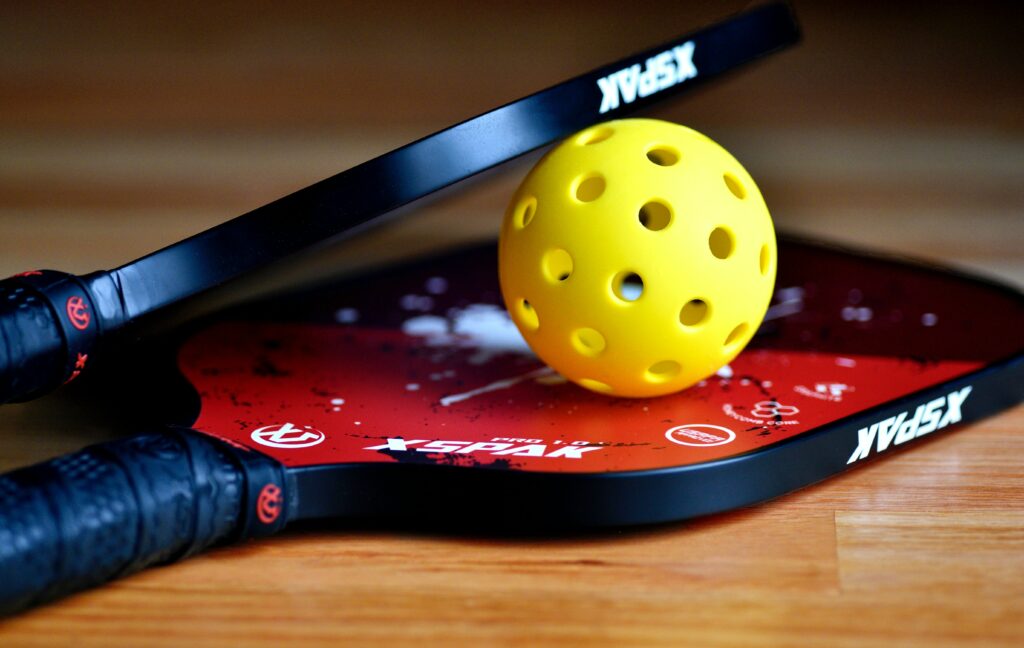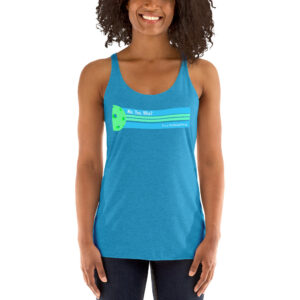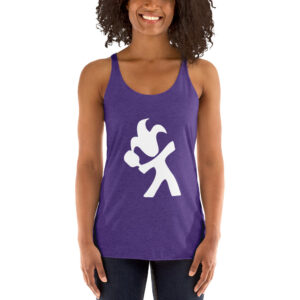The Why, What, and How of the Pickleball Paddle
It doesn’t take a lot of gear to play pickleball, but the paddle is one essential piece. Here’s a rundown of the history, the parts and composition, and the basic usage of the pickleball paddle explained.
Why: History of the Pickleball Paddle
The first pickleball paddles were actually ping pong paddles. When the game was invented it was played on an old badminton court using table tennis paddles and a perforated plastic ball. The paddles quickly evolved into wooden paddles specifically made for pickleball. In the 1970s, designs for the first composite paddles were introduced by Arlen Paranto.
What: Pickleball Paddle Dimensions, Weight, and Composition
Dimensions
Like other racquet sports, there are some variations when it comes to the size and design of the racquet (or paddle in this case). The official USAP rulebook, states that:
“The combined length and width, including any edge guard and end cap, shall not exceed 24 inches (60.96 cm). The paddle length cannot exceed 17 inches (43.18 cm). There is no restriction on paddle thickness”.
In other words, pickleball paddles can be a range of widths and lengths, but the total length plus the total width cannot exceed 24 inches. If you opt to use a pickleball paddle with a longer face, the paddle will have to be narrower than traditional designs to meet regulation criteria.
The majority of pickleball paddles available have a width of between 7 inches (17.78cm) & 8 inches (20.32cm) and a length of 15 inches (38.10cm) – 16 inches (40.64cm). Pickleball paddles within this range offer all-around power, control and balance.
These dimensions places the pickleball paddle as the middle child of racket sports. It’s smaller than a tennis racket and larger than a table tennis paddle.
Pickleball Paddle Dimensions Diagram
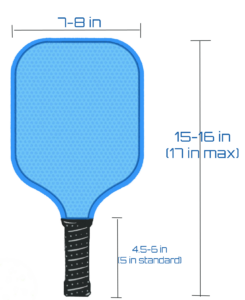
Racket versus paddle comparison
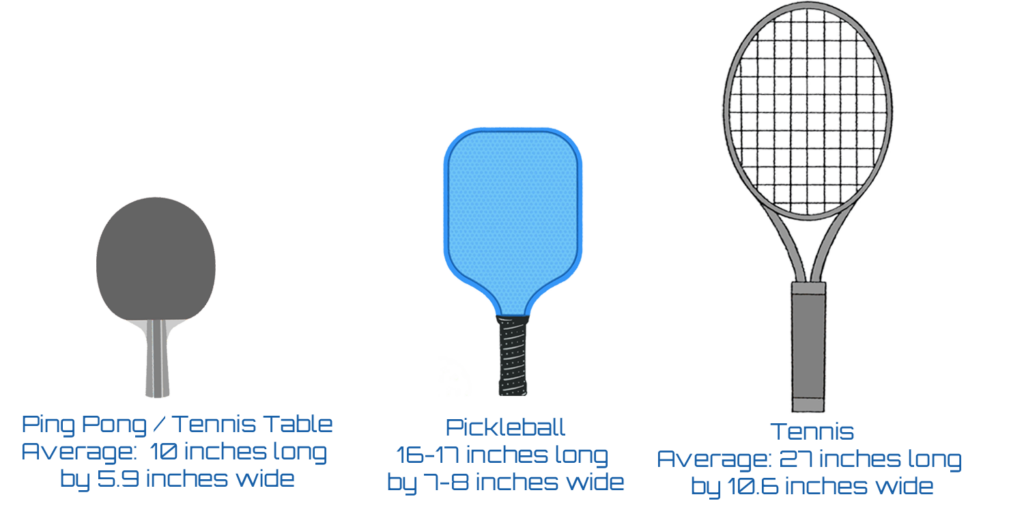
Weight
There are no restriction in the USAP official rulebook regarding pickleball paddle weight. Most pickleball paddles weigh between 7.2oz (204g) – 8.5oz (241g). Heavier paddles tend to provide more power, while lighter paddles give more control and precision. Most first-time players will opt for a mid-weight paddle, to get a good balance of both power and control.
Composition
Parts of the Pickleball Paddle
Here are the different parts that make up a pickleball paddle.
- Face – The face of the pickleball paddle is used for hitting the pickleball ball. The face is made from graphite, wood or a carbon polymer.
- Edge Guard – The edge guard is situated around the perimeter of the paddle’s face. The guard protects the face from damage and helps to maintain its shape
- Throat – The throat is the part of the paddle that connects the handle to the face. The throat is usually made of the same material as the face of the paddle.
- Handle – As you’d expect, the pickleball paddle handle is the part that a player holds during a game. It is often made of wood, graphite or a carbon polymer.
- Grip tape – The grip tape, or grip, is the outer part of the handle; the part which your hand makes contact with when you hold the handle. Pickleball paddle grips are usually made of rubber or a synthetic material such as polyurethane (PU).
- End Cap – The end cap is found at the bottom of the handle. End caps, also known as “butt caps” protect the bottom of the handle and can extend the length of the handle slightly.
Pickleball paddle parts diagram
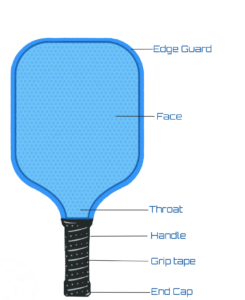
Pickleball Paddle Handle and Grip
Handle
The length of the handle can vary between 4.5 to 6 inches with 5 inches begin standard. Because the total length plus the width of the paddle cannot exceed 24 inches, every inch you add to the handle length takes away some surface area of the paddle face. If you use two hands all the time then you’ll want at least 5.25 inches of handle length. If you don’t use two hands then a standard 5 inch handle length will be fine.
Grip
- Hold your hand out in front of you so your palm and fingers point straight up into the air
- Align the bottom of a ruler with the bottom of the lateral crease (the bottom horizontal line) of you palm
- Measure to the top of your ring finger
The measurement will usually fall somewhere between 4 inches and 5 inches
| Pickleball Grip Size Chart | |||
|---|---|---|---|
| Palm measurement in inches | Size in cm | European Sizes | US Sizes |
| 3.94″ – 4.06″ | 10 – 10.3cm | 0 | 4 inches |
| 4.06″ – 4.17″ | 10.3 – 10.6cm | 1 | 4 ⅛ inches |
| 4.17″ – 4.33″ | 10.6 – 11.0cm | 2 | 4 ¼ inches |
| 4.33″ – 4.45″ | 11.0 – 11.3cm | 3 | 4 ⅜ inches |
| 4.45″ – 4.65″ | 11.3cm – 11.8cm | 4 | 4 ½ inches |
| 4.65″ – 4.72″ | 11.8 – 12.0cm | 5 | 4 ⅝ inches |
| 4.72″ – 4.84″ | 12.0 – 12.3cm | 6 | 4 ¾ inches |
Pickleball Paddle Materials
The days of the wooden paddle are long gone. The modern pickleball paddle uses composite material for both better conditions for the player as well as reduced sound for your neighbors. The paddle composition is made of core material and the face or surface material.
Core
Polymer is the most common core material used. It may be referred to as poly, polypropylene, or something similar. While most use polymer, not all polymer cores are the same. The quality and density matter. Higher end paddles will use a higher quality density that lasts longer and provides more consistence across the face. A higher density core uses smaller honeycomb cells so more of them are packed into the paddle. This gives the paddle a harder, firm feeling and offers more power compared to bigger celled cores. Unless a brand calls out that they are using a higher density core, you can assume they are using the standard bigger honeycomb cells.
Paddle Surface Material
Fiberglass, carbon fiber, and graphite are the three facing materials used. The facing of the paddle will affect the power, control, and size of the sweet spot. Fiberglass offers the most power. Carbon fiber gives you better feel and a larger sweet spot. Graphite is a little more cost effective but plays very similarly to a carbon fiber face.
How: Pickleball Paddle Technique
Grips
In pickleball, you’ll most likely use one of three grips when you’re playing: the eastern, the western, or the continental grip. Each of the grips come with their own advantages. Choosing the best grip for you comes down to what best suits your mechanics and game style, but more importantly, what feels most comfortable in your hand when you pick up your pickleball paddle.
Eastern
The Eastern grip is the most common and is a neutral grip that can be used for both forehands and backhands. Known as the handshake grip, the grip resembles how you would shake someone’s hand.
Western
The Western pickleball grip is less common and favors the forehand grip, offering more spin. It resembles how you may hold a frying pan when you flip a pancake. While it give a lot of spin on the forehand, the Western grip sets up a difficult angle when attempting a backhand.
Continental
Opposite of the Western, the Continental favors a player’s backhand more than their forehand because of the angle of the paddle in your hand. This grip is relatively common as many player’s often remain in a backhand grip to block volleys back to their opponents while at the kitchen line. It does make hitting a forehand difficult without changing your grip to accommodate.

